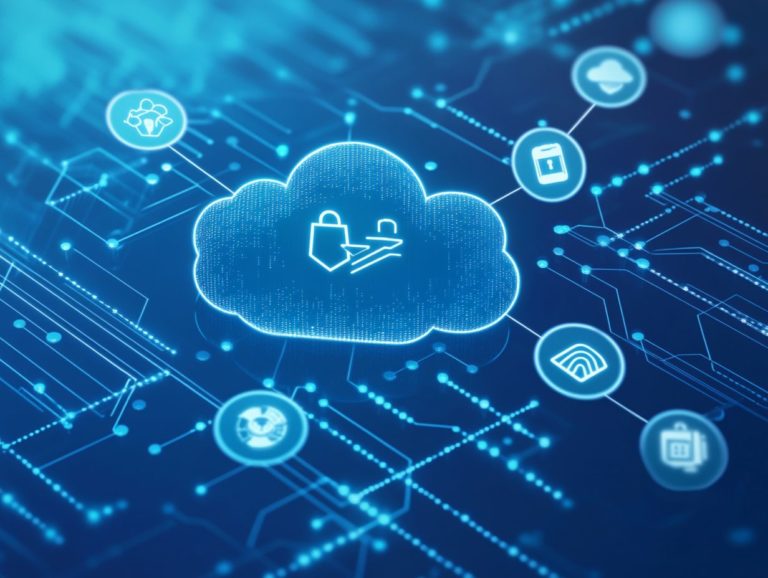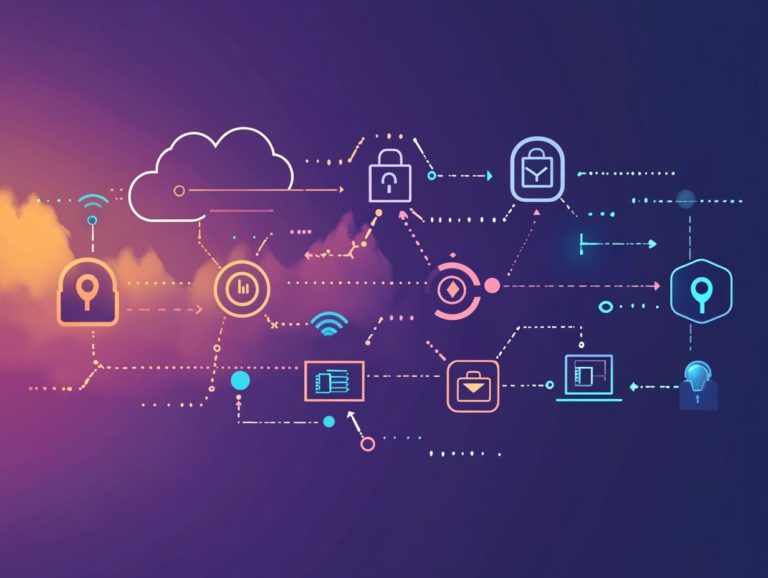The Future of Cloud Security: Trends to Watch
As you navigate the transition to the cloud, understanding cloud security is crucial.
This article explores current cloud security, focusing on common threats and vulnerabilities that organizations like yours face.
Discover trends like the growing use of AI for security, the shift towards a zero trust model, and the importance of data privacy and compliance.
We will also discuss the challenges of securing cloud environments and provide solutions to bridge security gaps.
Join us to explore these essential aspects that shape the business landscape in our digital age.
Contents
- Key Takeaways:
- What is Cloud Security?
- Current State of Cloud Security
- Emerging Trends in Cloud Security
- Challenges and Solutions for Cloud Security
- The Future of Cloud Security
- Frequently Asked Questions
- What is the importance of keeping up with the trends of cloud security?
- How are advancements in artificial intelligence and machine learning impacting cloud security?
- What are some emerging trends in cloud security that organizations should pay attention to?
- How important is employee education and training in ensuring cloud security?
- What role do cloud service providers play in ensuring cloud security?
- How will the future of cloud security be impacted by the increasing use of IoT devices?
Key Takeaways:

The future of cloud security is evolving. Businesses must stay updated on trends to protect their data.
AI and machine learning enhance cloud security and identify threats, making them vital tools against cyber attacks.
With remote work and data privacy concerns rising, adopting a zero trust model and complying with regulations is crucial.
What is Cloud Security?
Cloud security includes the policies, technologies, and controls you use to protect data and applications in the cloud.
As your business migrates to cloud environments, you ll face challenges like data breaches and compliance demands.
This field involves strategies like security posture management, essential for keeping your sensitive information safe.
Current State of Cloud Security
The cloud security landscape is dynamic. Businesses face vulnerabilities from phishing attacks and risks, such as those from MOVEit.
As you embrace cloud apps and multi-cloud strategies, staying informed about the future of PaaS and security trends is vital for safeguarding your data.
Common Threats and Vulnerabilities
Common cloud security threats include data breaches and phishing attacks. With reliance on cloud apps, your organization may become a target for cybercriminals.
Data breaches often occur due to inadequate access controls, allowing unauthorized users into your systems.
Phishing can trick employees into revealing their credentials, leading to compromised accounts.
Misconfigured settings may create loopholes, leaving data exposed. These threats can undermine business integrity and erode customer trust.
To reduce these risks, your organization should adopt strong identity management, conduct security audits, and educate employees on recognizing threats.
Emerging Trends in Cloud Security
New trends are changing how you protect digital assets, with AI and machine learning improving threat detection.
Adopting a zero trust model is increasingly essential to strengthen defenses against sophisticated attacks in multi-cloud and hybrid environments.
Increased Adoption of AI and Machine Learning

The growing adoption of AI and machine learning in cloud security is revolutionizing your threat detection capabilities, empowering you to analyze vast data sets for any suspicious activities.
By harnessing advanced algorithms, your security team can proactively identify threats and respond with real-time insights, significantly enhancing your strong security management.
This transformation is made possible by powerful tools like AWS GuardDuty, which effectively employs machine learning models to detect unusual activities in user behavior and network traffic.
Microsoft Azure Sentinel uses AI to automate security incident responses, allowing your business to streamline operations while reducing response times.
These advanced technologies not only improve threat identification but also minimize false positives, enabling your security professionals to concentrate on genuine risks.
The results are exciting! Faster incident resolution leads to stronger security, ultimately creating a safer cloud environment for organizations of all sizes.
Shift Towards Zero Trust Architecture
The zero trust architecture changes how we think about cloud security, underscoring that no user or device should be automatically trusted. This model requires you to continuously verify user identity and device health, a necessity for maintaining a strong security posture in today s intricate threat landscape.
As you adopt this approach, it’s essential to systematically implement identity and access management (IAM) alongside rigorous data protection protocols. This ensures that every access request is evaluated based on multiple criteria, adding layers of security.
One of the standout benefits of zero trust architecture is its ability to significantly reduce the risk of data breaches by limiting lateral movement, or unauthorized access, within networks, especially in hybrid and multi-cloud environments.
Transitioning to this framework can indeed pose challenges, such as integrating legacy systems and overcoming employee resistance to change. To navigate these obstacles, consider phased implementations, comprehensive training programs, and leveraging automated tools to enhance the monitoring and enforcement of your security policies.
Importance of Data Privacy and Compliance
Data privacy and compliance stand at the forefront of cloud security, as you must navigate a complex landscape of regulations that dictate how sensitive information is handled. With data breaches becoming alarmingly common, ensuring adherence to regulations like GDPR and HIPAA is essential for safeguarding customer trust and minimizing legal risks.
These laws set strict rules for data handling, compelling you to establish comprehensive security measures. For example, GDPR requires that you implement data protection by design and by default, which necessitates the adoption of advanced encryption techniques and regular audits.
In a similar vein, HIPAA demands that healthcare providers employ secure systems to protect patient information, leading to a greater investment in cybersecurity infrastructure.
Organizations that fall short of these standards not only face substantial fines but also risk tarnishing their reputation. This reality highlights the critical need for robust security protocols as a fundamental aspect of your data management strategy.
Challenges and Solutions for Cloud Security
You encounter a myriad of challenges in cloud security, especially as you integrate operational technology and embrace DevOps security practices.
From navigating vulnerabilities in cloud-native applications to meeting compliance requirements, it s essential for you to identify effective solutions that protect your digital assets from ever-evolving threats.
Act now to tackle these cloud security challenges and protect your assets.
Addressing Security Gaps and Risks
Addressing security gaps and risks is crucial for maintaining robust cloud security. By conducting thorough assessments and implementing proactive measures, you can strengthen your defenses against potential vulnerabilities and ensure compliance with industry standards.
To effectively identify these gaps, consider adopting methodologies such as:
- Risk assessments
- Vulnerability scanning
- Penetration testing
These practices will help you uncover weak points before they can be exploited.
Conduct regular audits and monitor cloud configurations while prioritizing employee training on security protocols.
When crafting a comprehensive security strategy, integrate compliance requirements like GDPR or HIPAA alongside industry best practices. This will help create a resilient framework that safeguards data and fosters trust among stakeholders.
Emphasizing continuous improvement empowers your organization to adapt its strategies to evolving threats.
Implementing Robust Security Measures

Implementing robust security measures is crucial for your organization if you are looking to enhance your cloud security posture and effectively detect threats. This means adopting established security frameworks and leveraging advanced technologies.
Additionally, fostering a culture of security awareness throughout your team is vital.
To achieve these objectives, consider employing Cloud Native Application Protection Platforms (CNAPP), which are tools that help secure applications in the cloud. These platforms offer comprehensive visibility and protection throughout the application lifecycle, which is invaluable.
Integrating threat detection tools allows for the timely identification of vulnerabilities and suspicious activities. Maintaining an effective security posture requires regular assessments and updates to your security policies to ensure they remain aligned with evolving threats.
Continuous monitoring is essential for quickly responding to emerging risks. Equally important is training your employees on cybersecurity best practices, empowering them to recognize potential threats and adhere to security protocols.
This not only reinforces your organization s overall security framework but also transforms your team into a formidable line of defense.
The Future of Cloud Security
The future of cloud security will be defined by technological advancements and the ever-changing landscape of cyber threats. To stay ahead, you will need to adopt proactive strategies, keeping an eye on the future of cloud storage trends as a cybersecurity executive.
As organizations embrace edge computing and seek real-time insights, you ll need to implement innovative security solutions to effectively address emerging vulnerabilities.
Predictions and Potential Impact on Businesses
Predictions for the future of cloud security suggest you will increasingly rely on operational technology and advanced analytics to enhance your threat detection and response capabilities, especially in light of the top 10 cloud security threats to watch out for.
It is essential to prepare for a landscape where security is woven into every aspect of your operations, fundamentally transforming your approach to managing security posture.
To navigate this evolving terrain, prioritize the convergence of security protocols with your operational frameworks. This integration strengthens defenses against emerging threats and simplifies compliance with regulatory standards, which are becoming more closely linked to technological advancements.
By harnessing real-time data and predictive analytics, you can adopt a proactive stance, identifying vulnerabilities before they are exploited. Fostering a culture of collaboration between your security and IT departments will be vital, enabling a unified approach to risk management and operational efficiency.
As the threat environment continues to evolve, organizations that adapt their strategies accordingly will bolster their resilience and maintain a competitive edge.
Frequently Asked Questions
What is the importance of keeping up with the trends of cloud security?
As the use of cloud technology continues to grow, it becomes increasingly important to stay updated on the top hybrid cloud trends to watch in 2024. This helps organizations and individuals protect their sensitive data and mitigate potential risks and threats.
How are advancements in artificial intelligence and machine learning impacting cloud security?

AI and machine learning significantly boost cloud security. They enable real-time threat detection and automate incident responses.
These technologies also spot patterns in data, making it easier to prevent cyber attacks.
What are some emerging trends in cloud security that organizations should pay attention to?
Zero trust architecture restricts network access only to authorized users and devices. Tools that help protect cloud data and applications are also gaining traction.
Another exciting trend is using blockchain technology for secure data storage and sharing.
How important is employee education and training in ensuring cloud security?
Employee education is vital for strong cloud security. Everyone should know security best practices like creating strong passwords and spotting phishing scams.
Proper training can dramatically reduce the risk of mistakes that lead to security breaches.
What role do cloud service providers play in ensuring cloud security?
Cloud service providers are key players in cloud security. They implement security measures and maintain the safety of their infrastructure.
Choosing a reliable provider is crucial to keeping your data safe.
How will the future of cloud security be impacted by the increasing use of IoT devices?
The rise of IoT devices introduces new challenges for cloud security. These devices often have weaker security and can be gateways for cyber attacks.
The future of cloud security will focus on securing and managing these devices, particularly as we look at the future of SaaS trends to prevent vulnerabilities.






